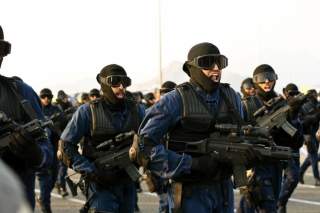Saudi Arabia's Defense Doctrine Is Missing Something: Defense
Riyadh’s new approach to war is full of bad assumptions.
The exclusive reliance on military force has made Saudi Arabia’s regional foreign policy approach much more rigid. That is, diplomatic maneuvering and fighting wars are hardly synchronized in Saudi foreign policy. A hard mindset to fight and win the war in Yemen, or slug out the Syrian Civil War, has necessarily limited the room for political and diplomatic maneuvers.
During the 1980s, U.S. president Ronald Reagan pursued a highly confrontational approach to the Soviet Union after declaring it an “evil empire.” A new doctrine was thus born: the militarily charged Reagan doctrine, which replaced the doctrine of containment developed by the Truman administration in the immediate postwar period. But President Reagan was also quick to capitalize on the normalization initiatives of Soviet leader Mikhail Gorbachev, to promote America’s national interests and security. The Saudi defense doctrine prioritizes reliance on military force to make the way, and seemingly deemphasizes diplomatic flexibilities to open up back-channel dialogues and cooperation with regional opponents to resolve regional problems.
A grey area of the doctrine is the projection of Iran as a serious threat to Saudi national security, because the so-called “Iran threat” remains undefined. Stretching over the entire east coast of the Persian Gulf, the Shia powerhouse is a challenger to Saudi dominance, but may not be a direct threat to Saudi security. To many observers, the “Iran threat” is more shrouded in propaganda and less realistic. Historically, the Iranians have suffered more at the hands of the Arabs, recent examples being Saudi Arabia and other Gulf Arab states’ huge financial support for the Iraqi war on Iran (1980–88), and Saudi Arabia’s cooperation with the U.S.-led Western sanctions regime to damage Iran economically and isolate it politically. Currently, Iran and Saudi Arabia have no serious territorial and resource-sharing conflicts that would justify their labelling each other as a threat. If Iran remains a credible threat, the defense doctrine should spell out exactly how. Similarly, Iran often projects Saudi Arabia as a source of regional threats without clearly explaining how the Saudis threaten Iranian security.
Another grey area is the absence of well-defined objectives tied to the defense doctrine. The different postwar U.S. military doctrines, for example, were developed to counter clearly defined dangers (such as the Soviet communist threat) and to defend clearly defined objectives (such as democracy, human rights, free-market economics and a liberal international trade order). The Saudi doctrine revolves around the idea of wiping out internal and external threats, while lacking in greater purposes of any sort to defend and promote. Will the doctrine die once the threats evaporate?
The defense doctrine has also a problem of undefined reliance on U.S. military support. Currently, Riyadh coordinates policies with the United States to refurbish the various rebel groups in Syria, substantially depends on U.S. support to fight in Yemen and largely relies on U.S. arms supplies to keep the wars in Syria and Yemen running. The defense doctrine may lose its operability and war fighting capacity if the United States decides not to commit to Saudi defense needs, either under international pressures or domestic political considerations.
Finally, Heading to Where?
In its present form, the Saudi defense doctrine sounds more like a highly offensive doctrine—a doctrine primarily intended to fight and win wars. It leaves out the idea of defensive defense to discourage and deter enemy attacks through self-defense preparedness, in case a real war situation becomes a reality. The doctrine also looks to prevent, not to accommodate, Iran’s reemergence as a regional power. Iran’s rise is a reality, and it is set to affect the regional status quo by generating a new set of reconfigurations in the region’s political and military forces. Seeking military solutions to every problem may be counterproductive in terms of killing, human-rights violations and the destruction of economic infrastructure, as is the case in Yemen as well as Syria. This is also true of other parties involved in the wars, including Iran, Russia and the United States. That means there is a serious need to revisit and recast the doctrine to strike a chord between means, ends and the realities.
Mohammed Nuruzzaman is associate professor of international relations at Gulf University for Science and Technology in West Mishref, Kuwait.
Image: Saudi security forces on parade. Wikimedia Commons/Omar Chatriwala/Al Jazeera English

